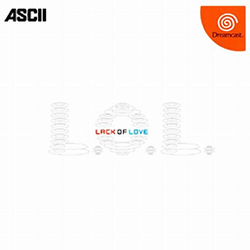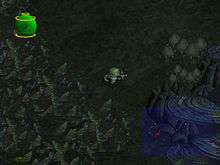L.O.L.: Lack of Love
| L.O.L.: Lack of Love | |
|---|---|
 Japanese Dreamcast cover art | |
| Developer(s) | Love-de-Lic |
| Publisher(s) | ASCII Entertainment |
| Director(s) | Kenichi Nishi |
| Producer(s) | Hiroshi Suzuki |
| Designer(s) |
Keita Etō Hiroaki Ishibashi |
| Writer(s) | Kenichi Nishi |
| Composer(s) |
Ryuichi Sakamoto (music) Hirofumi Taniguchi (sound) |
| Platform(s) | Dreamcast |
| Release date(s) | |
| Genre(s) | Life simulation |
| Mode(s) | Single-player |
L.O.L: Lack Of Love, is an evolutionary life simulation game developed by Love-de-Lic and published by ASCII Entertainment for the Sega Dreamcast. The game was released exclusively in Japan on November 2, 2000.
Gameplay

The gameplay of L.O.L.: Lack of Love revolves around the player's control of a single creature placed on an alien planet during robotic terraforming. The player must cause the creature to evolve into a new form by communicating with other living creatures, establishing symbiotic relationships with them, and thus helping them.[2] The game is non-linear, lacking a HUD almost entirely and requiring the player to simply remain alive. This can be done by helping, or eating other creatures, as well as performing various bodily functions including sleeping and urinating.[3]
Development
L.O.L.: Lack of Love is the last in a trio of games developed by Love-de-Lic. It was directed by Kenichi Nishi and produced by Hiroshi Suzuki. The game was designed by Keita Eto and Yoshiro Kimura, the latter of whom had already left Love-de-Lic and began working on other projects with his company Punchline.[4] The musical score for L.O.L.: Lack of Love was created by film composer Ryuichi Sakamoto, who was also the game's scenario writer. Nishi and Sakamoto met at Club Eden via a mutual friend and, through a series of e-mails, began discussing James Lovelock’s Gaia hypothesis.[2] This theory states that the earth's living organisms function in harmony and respond to ecological changes in order for the planet to sustain life. "We should care for other people, life, the environment and nature," Nishi explained about the game's message. "Sakamoto came up with the title. We wanted to question the way in which our lifestyle lacks love."[2]
The team first considered developing the game for the PlayStation, but Nishi was convinced by Sega's president to develop it for the Dreamcast beginning in 1998.[2] Nishi intended to communicate the game's themes without text or voices. This was done by setting the scene with a long opening sequence and utilizing various puzzles akin to a point-and-click adventure game. A communication system between the organisms consisting of sound and movement was used due to the Dreamcast's inability to perform graphical facial expressions.[2] It was Nishi's idea to implement a cycle of eating and excreting. One of the player character's evolutionary forms resembles a black-and-white puppy, which is based on Nishi's real-life dog Tao.[2] Sakamoto's 13-track score is made up of only abstract, synthesized electronic music with most of the songs composed to evoke a sense of a sadness or loneliness in the listener.[5] The soundtrack was released on a single disc in Japan by Warner Music Japan on November 8, 2000.[6]
Reception and legacy
The four reviewer panel of the Japanese magazine Famitsu gave L.O.L.: Lack of Love scores of 9, 6, 6, and 8 for a total of 29 out of 40.[7] Robert Florence of the Scottish web series Consolevania described the game was "effortlessly one of the best games on the Dreamcast" due to the number of ambitious ideas present and the unique concept that binds these ideas together.[8] The staff at Computer and Video Games was also impressed by its originality and described the soundtrack as "one of videogaming's finest audio moments".[9] Despite having no language barrier, Anoop Gantayat of IGN was unsure of the game's overall message. Gantayat questioned, "Your long-term goal in the game? To live, apparently - at least that's what the instruction manual says. Your short term goal? To advance to the next field of play, I presume."[3]
L.O.L.: Lack of Love sold poorly at Japanese retail. GamesTM suggests that it was not picked up for either North America or European release because its "theme and setting certainly separate it from the bankable generic titles that clog up most of the top ten in any given year."[2] The magazine considered L.O.L.: Lack of Love as "one of the Dreamcast's best-kept secrets" and a collector's item that currently fetches high prices on auction websites.[2] Nishi has expressed interest in remaking the game. "If I have a chance, I would like to remake LOL for another console and release it again," the director elaborated. "I believe Lack of Love would be accepted more widely now because we are more seriously dealing with climate change and global warming."[2]
References
- ↑ IGN Staff (September 11, 2000). "Latest Release Dates Out of Japan". IGN. Retrieved 2011-04-09.
- 1 2 3 4 5 6 7 8 9 "Behind the Scenes – LOL: Lack of Love". GamesTM. The Ultimate Retro Companion. No. 3. Imagine Publishing. 2010. p. 117. ISSN 1448-2606. OCLC 173412381.
- 1 2 Gantayat, Anoop (December 1, 2000). "L.O.L. (Import)". IGN. Retrieved 2011-04-09.
- ↑ 1UP Staff. "Sealed With a Kiss". 1UP.com. Retrieved 2008-10-27.
- ↑ L.O.L.: Lack of Love (Liner) (in Japanese). Ryuichi Sakamoto. Warner Music Japan. 2000.
- ↑ "L.O.L.(LACK OF LOVE)" (in Japanese). Amazon.com. Retrieved 2011-04-09.
- ↑ IGN Staff (October 27, 2000). "Japanese Magazine Scores, and a TGS Booth Babe". IGN. Retrieved 2011-04-09.
- ↑ Florence, Robert. "Dreamcasts From Another World". Consolevania. Series 2. Episode 8.
- ↑ NGamer Staff (October 21, 2008). "Wii Feature: Dreamcasting the Net". Computer and Video Games. Retrieved 2011-10-23.
External links
- Official website (web archive) (Japanese)